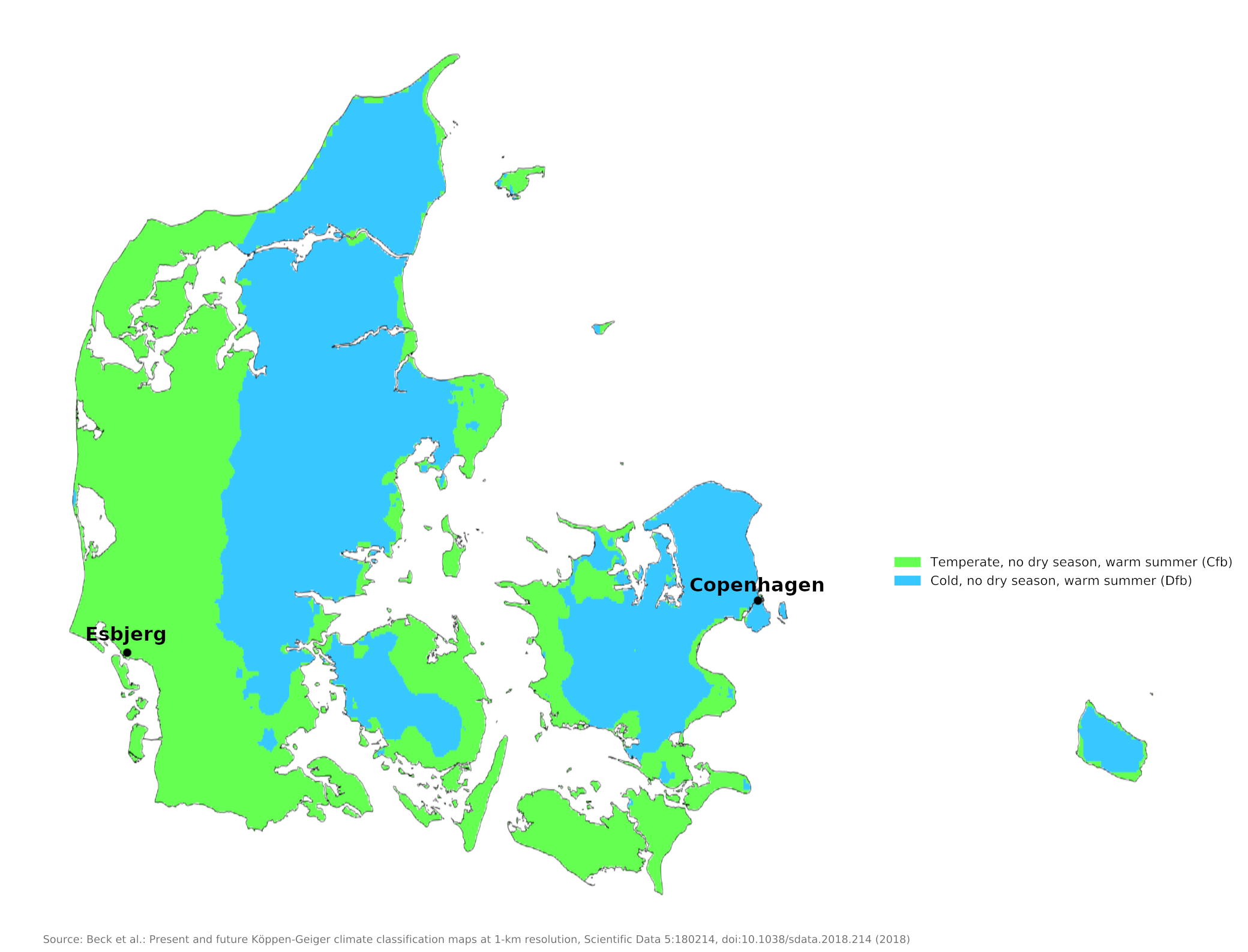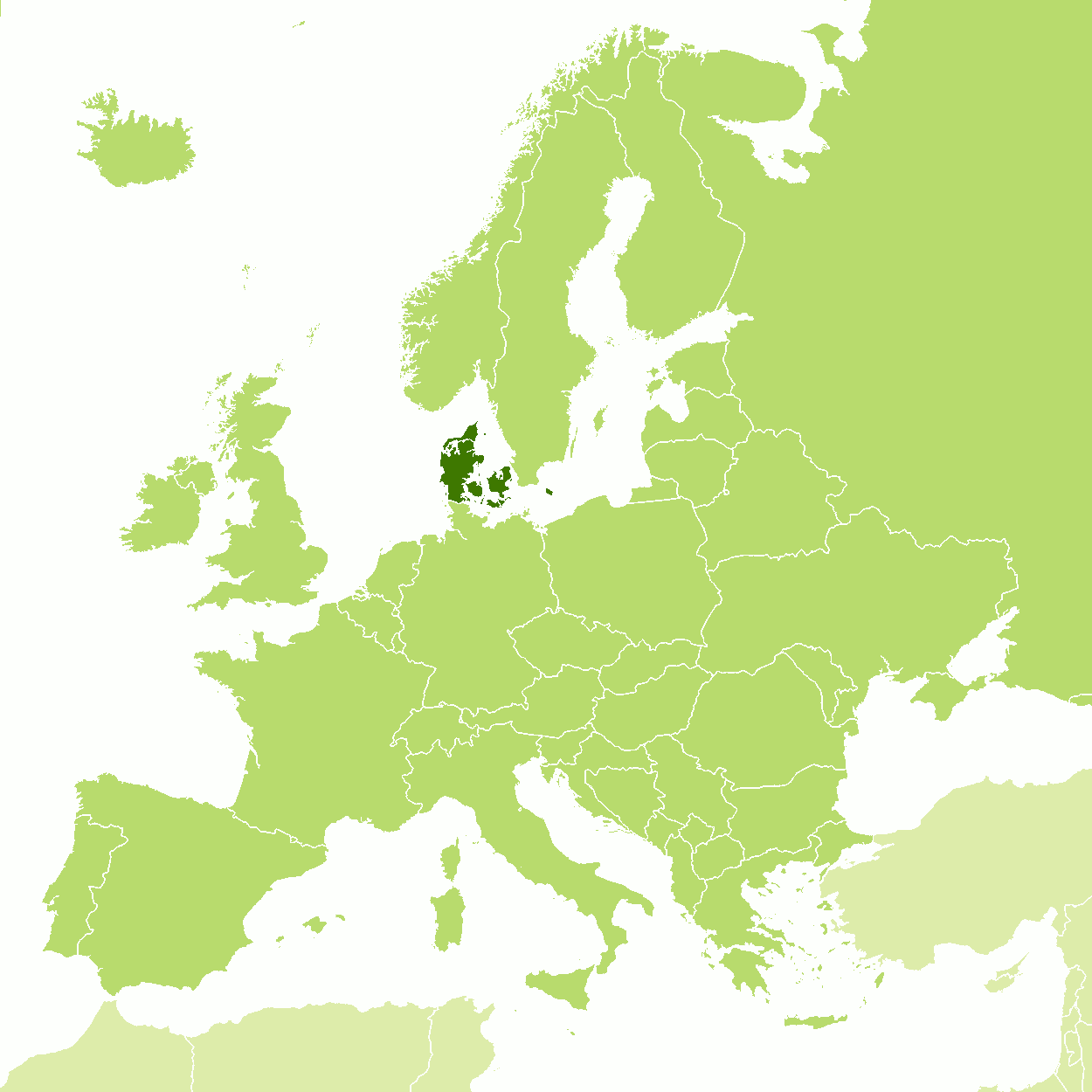The Climate of
Denmark
 Kettinge Kirke, Lolland
Kettinge Kirke, Lolland
Climate Map
 Climate map of Denmark
Climate map of Denmark
What is the climate of Denmark like?
Denmark consists of the peninsula of Jutland and a group of islands at the entrance to the Baltic Sea, between Sweden and Germany. Denmark's cool maritime climate is rather similar to that of Britain or the state of Washington. Because of its small size and low elevation—no part of Denmark is higher than 180 meters (600 feet)—weather and climate do not vary much throughout the country.
Denmark has a temperate climate, the mildness of which is largely conditioned by the generally westerly winds and by the fact that the country is virtually encircled by water. There is little fluctuation between day and night temperatures, but sudden changes in wind direction cause considerable day-to-day temperature changes. The mean temperature in February, the coldest month, is 0°C (32°F), and in July, the warmest, 17°C (63°F). The islands have, upon the whole, a somewhat warmer climate than Jutland.
Spells of cold weather occur in most winters when the waters of the Baltic freeze in whole or in part. A fringe of ice generally lines the greater part of the Danish coasts on the eastern side for some time during the winter. In some winters such spells may be prolonged. If this happens the waters of the Sound between Zeeland and south Sweden may freeze. The average duration of winter snow cover is about thirty days but in some winters there may be little snow.
Conditions in summer are variable from year to year and from day to day. Although spells of warm, settled weather may last for a few weeks in some years, it rarely becomes unpleasantly hot.
Rainfall occurs all the year round, but summer and autumn are the wettest seasons. The annual rainfall varies between 550 and 750 millimeters (22 and 30 inches) in different years and different localities. It is highest on the west coast of Jutland. More than half the rainfall occurs from July to November; the driest month is April. Thunderstorms are frequent in the summer.
When Atlantic storms cross the country or move into the North Sea, quite severe gales may affect Denmark, and the west coast has the reputation of being particularly exposed and windswept. Such gales may occur at all times of the year but are less frequent and less severe in summer. Denmark has a generally pleasant climate the year round and, apart from the occasional cold winter, rarely suffers extremes of weather. Daily sunshine hours range from between one and two in winter to about eight in summer.
| Climate data for Copenhagen (1981–2010) | |||||||||||||
|---|---|---|---|---|---|---|---|---|---|---|---|---|---|
| Month | Jan | Feb | Mar | Apr | May | Jun | Jul | Aug | Sep | Oct | Nov | Dec | Year |
| Average high °C (°F) | 3.4 (38.1) | 3.6 (38.5) | 6.5 (43.7) | 11.8 (53.2) | 16.7 (62.1) | 19.6 (67.3) | 22.2 (72.0) | 21.8 (71.2) | 17.5 (63.5) | 12.6 (54.7) | 7.6 (45.7) | 4.4 (39.9) | 12.3 (54.1) |
| Daily mean °C (°F) | 1.4 (34.5) | 1.4 (34.5) | 3.5 (38.3) | 7.7 (45.9) | 12.5 (54.5) | 15.6 (60.1) | 18.1 (64.6) | 17.7 (63.9) | 13.9 (57.0) | 9.8 (49.6) | 5.5 (41.9) | 2.5 (36.5) | 9.1 (48.4) |
| Average low °C (°F) | −0.7 (30.7) | −0.8 (30.6) | 0.7 (33.3) | 4.2 (39.6) | 8.6 (47.5) | 11.9 (53.4) | 14.3 (57.7) | 14.1 (57.4) | 10.8 (51.4) | 7.1 (44.8) | 3.3 (37.9) | 0.5 (32.9) | 6.2 (43.2) |
| Average precipitation mm (inches) | 53.0 (2.09) | 36.9 (1.45) | 42.3 (1.67) | 35.8 (1.41) | 47.2 (1.86) | 63.9 (2.52) | 60.9 (2.40) | 67.5 (2.66) | 61.0 (2.40) | 63.3 (2.49) | 56.4 (2.22) | 57.4 (2.26) | 645.7 (25.42) |
| Source: Danish Meteorological Institute | |||||||||||||
| Climate data for Esbjerg (1961–1990) | |||||||||||||
|---|---|---|---|---|---|---|---|---|---|---|---|---|---|
| Month | Jan | Feb | Mar | Apr | May | Jun | Jul | Aug | Sep | Oct | Nov | Dec | Year |
| Average high °C (°F) | 2.5 (36.5) | 2.7 (36.9) | 5.1 (41.2) | 9.5 (49.1) | 15.0 (59.0) | 18.2 (64.8) | 19.2 (66.6) | 19.8 (67.6) | 16.6 (61.9) | 12.6 (54.7) | 7.6 (45.7) | 4.2 (39.6) | 11.1 (52.0) |
| Daily mean °C (°F) | 0.7 (33.3) | 0.7 (33.3) | 2.7 (36.9) | 6.1 (43.0) | 11.1 (52.0) | 14.4 (57.9) | 15.9 (60.6) | 16.1 (61.0) | 13.5 (56.3) | 10.0 (50.0) | 5.6 (42.1) | 2.4 (36.3) | 8.3 (46.9) |
| Average low °C (°F) | −1.3 (29.7) | −1.6 (29.1) | 0.3 (32.5) | 3.0 (37.4) | 7.5 (45.5) | 11.2 (52.2) | 12.9 (55.2) | 12.9 (55.2) | 10.5 (50.9) | 7.4 (45.3) | 3.4 (38.1) | 0.3 (32.5) | 5.6 (42.1) |
| Average precipitation mm (inches) | 60 (2.4) | 41 (1.6) | 48 (1.9) | 40 (1.6) | 47 (1.9) | 55 (2.2) | 60 (2.4) | 72 (2.8) | 82 (3.2) | 94 (3.7) | 88 (3.5) | 72 (2.8) | 759 (29.9) |
| Source: Danish Meteorological Institute | |||||||||||||
References
- E. A. Pearce, Charles Gordon Smith, (1990) The Hutchinson World Weather Guide, John Murray Press. ISBN 1859863426
- Timothy L. Gall, (ed.), (2003), Worldmark Encyclopedia of the Nations, Eleventh Edition, Thomson Gale
- Hugh Chisholm, (ed.), (1911), Encyclopædia Britannica, Eleventh edition, Cambridge University Press
The Climate of
Denmark

In summary:
The climate in Denmark is temperate. Days are typically humid and overcast; winters are mild and windy, and summers are cool. The mean temperatures are 0°C (32°F) in February, the coldest month, and 17°C (63°F) in July, the warmest month.
Rainfall comes fairly evenly throughout the year, with the annual average amounting to approximately 600 millimeters (24 inches).